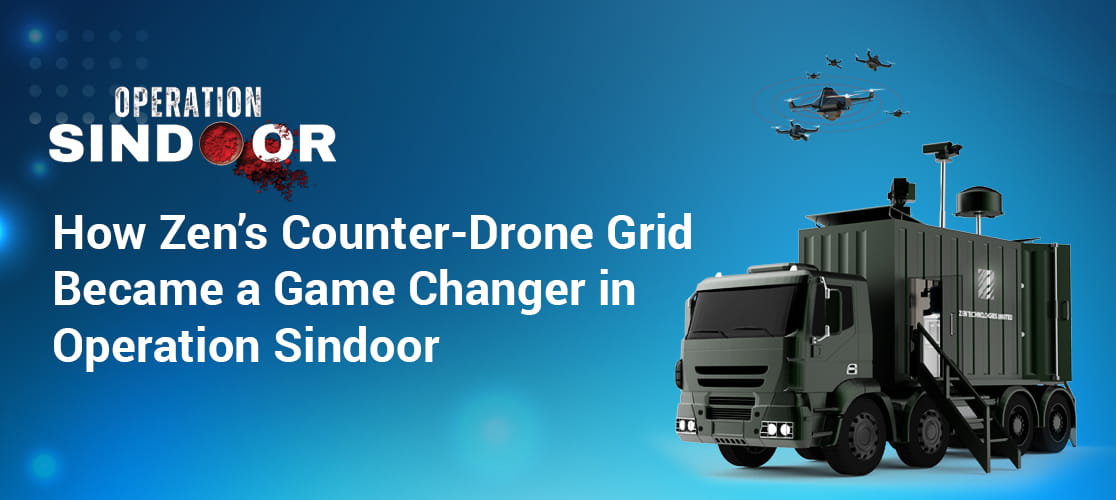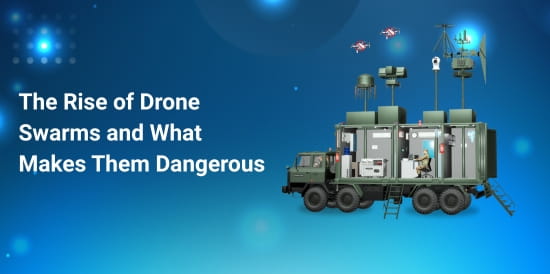
Operation Sindoor launched by India on 07 May 2025 in retaliation to a heinous massacre of 26 innocent civilians in Pahalgam in an act of cross-border terrorism orchestrated by our western neighbour was a game changer. India, through this operation not only set a new normal of zero tolerance to acts of terror, but it also set up a new doctrine that called for pro-active precision strikes to assert its will.
With Pakistan launching over 800 to 1000 drones across India’s western front and India countering the drone threat professionally and valiantly, this operation marked the first ever major drone-counter drone duel between the two arch-rivals. It is in the counter drone domain that Zen made a difference.
This conflict wasn’t just fought with bullets and missiles. It was fought with sensors, algorithms, and real-time intelligence. In the face of a determined and intense drone offensive duly backed by an onslaught of rocket artillery and missiles, India’s response was swift, calculated, and most importantly, successful. At the heart of that success was a quiet but formidable force – Zen Anti Drone System (Zen ADS).
How Zen Entered the Fight
For decades, Zen has worked behind the scenes in India’s defence ecosystem, but Operation Sindoor propelled the company into the spotlight. Way back in September 2021 Indian Air Force placed an order for a substantial number of Zen Anti Drone Systems to counter the drone-based threats. The systems were delivered in a phased manner in 2022-23. Later in June 2024, Zen successfully demonstrated its Hard-Kill Anti-Drone System, known as ADS HK, to the Army Air Defence College in Gopalpur.
Zen ADS system was designed not just to track drones but to detect, identify, and eliminate them with a very high probability of kill. While Zen ADS was based on a dual mode electro-optical and RF based detection duly coupled with a 3D X band radar for precise target location, the ADS HK combined the power of a L 70 gun firing smart ammunition to inflict a catastrophic hard kill. In an environment where seconds count, Zen’s system brought speed and finality to drone defence.
The Challenge of Sindoor
Operation Sindoor proved to be the perfect proving ground. Pakistan’s offensive included surveillance drones, armed UAVs, and even small autonomous platforms such as the Turkish Asisguard Songar, The threat package as a whole was lethal and with many machines having the capability to operate beyond the reach of conventional jamming systems. Many of these drones flew low and fast, either in twos or threes or as drone swarms presenting challenges that conventional air defence systems could not handle optimally.
While most of the soft-kill ADS operated in the commercial frequency bands of 2.4 Ghz or 5.8 GHz bands, Zen ADS was different. It had the capability of wider band operation even outside of the commercial bands. Since most of the drones from the adversary did use non-commercial bands, our ADS proved to be an effective killer to take them on. Complementing the above capability ADS HK system stepped up with kinetic certainty, neutralising threats with precision firepower.
Sensors That Think Fast
Zen’s system didn’t just work independently—it was part of a broader sensor and electronic warfare grid that enabled real-time detection, classification, and coordinated response. In that, the Zen ADS as a part of the air defence battle management chain based on Integrated Air Command and Control System (IACCS) duly handshaking with the Army’s Akashteer system worked seamlessly to take the threat head on. As stated, with wideband detection capability, Zen ADS could identify even those drones operating on obscure or shifting signals. The ADS HK was designed to integrate with legacy systems like the L-70, provided the much-needed hard kill capability. Our systems being rugged and mobile could be rapidly deployed in mixed-defence zones and scale up without logistical delays. In a fast-moving operation like Sindoor, this level of flexibility was not just useful, it was critical.
A Tactical Win with Strategic Consequences
By the end of the operation, over 70 drones had been neutralized, and not a single civilian casualty was reported. India’s multi-layered defence grid held the line, and Zen’s contribution was widely recognized by both defence analysts and the armed forces. Company leadership later confirmed that the system had played a vital role in the operation, while defence publications and strategic think tanks cited it as a turning point in India’s counter-drone capabilities. In the weeks that followed, Zen’s stock surged over 37 percent, and media headlines began to reflect a new truth: India’s private sector was no longer a support act, it was a front-line innovator.
Preparing for the Next Wave of Threats
But if Operation Sindoor was the present, the future would be even more complex. The threats are evolving rapidly. Drone swarms powered by AI, loitering munitions that can circle and strike at will, and even drones equipped with their own electronic warfare payloads are no longer the stuff of theory—they’re being tested in real conflicts. In such a landscape, it’s not enough to react. Systems must anticipate.
Zen Technologies is already preparing for this future, developing solutions that use machine learning to distinguish between a bird, a decoy, and a live drone in the few fleeting moments of the fast-moving air defence battle. The company is investing in modular swarm-resistance architecture, decentralized command systems, and mobile units that can be deployed and activated in under five minutes. It’s no longer just about firepower. It’s about intelligence, speed, and coordination.
A Milestone for Indigenous Innovation
This evolution also reflects a broader shift in India’s defence posture. Operation Sindoor validated not just Zen’s technology, but the entire philosophy of self-reliance and innovation embedded in the Atmanirbhar Bharat mission. For years, Indian defence procurement leaned heavily on imports, but Sindoor showcased the power of local manufacturing, indigenous R&D, and rapid deployment. Zen’s success story isn’t just about one company’s rise. It’s a case study of how public-private collaboration can build a stronger, smarter, and faster military infrastructure.
The System That Tipped the Balance
It’s worth noting that Zen didn’t enter the battlefield with a marketing campaign or promises. Instead, it arrived with a will and passion to serve cutting edge technology to our warriors. It proved that when hostile drones penetrate the airspace, what matters most is how fast and how decisively you can respond. Soft-kill systems have their place, and missile-based air defence is essential. But between those two layers lies a critical gap, and Zen’s ADS HK filled it with precision and clarity.
Shaping the Future of Combat
In the aftermath of Operation Sindoor, India’s defence strategy has undergone a recalibration. More orders for indigenous systems are being fast-tracked, and private-sector players like Zen are now part of the national security conversation in a way they never were before. As global conflicts continue to demonstrate the transformative power—and danger—of drones, one thing is clear: the countries that dominate the skies will be the ones who master detection, jamming, and elimination in real time.
Zen Technologies has shown that it’s ready for that responsibility. With proven systems in the field and next-gen innovations on the horizon, Zen is not just reacting to modern warfare; it’s shaping the future of it.





Leave feedback about this